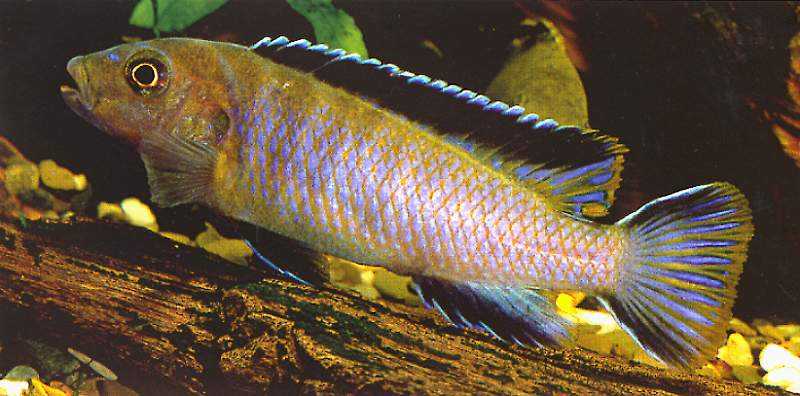

Chindongo longior (Seegers, 1996)
by Michael K. Oliver, Ph.D.
Above: The living holotype of Chindongo longior (previously called Pseudotropheus longior), BMNH 1995.8.15: 9 (86.7 mm SL), from Mbamba Bay, Tanzania; about 1000 meters south of Chinyangi Point, collected 14 April 1990 by B. Kilian and L. Seegers. Photographed alive in Germany an unspecified interval after collection.
Below at bottom of page: The same specimen (holotype), as preserved. Photos reproduced from Figs. 7 (color) and 9 (black & white) of Seegers (1996); used here with the generous permission of Dr. Lothar Seegers.
Chindongo longior is a fairly recently (1996) described relative of the more recently (2016) named C. bellicosus. According to the diagnosis in Seegers' description, C. longior belongs to the group of slender species within (what used to be) the Pseudotropheus elongatus complex; i.e., within what is now the genus Chindongo. (In contrast, C. elongatus itself, although "elongate" compared to most mbuna, is one of the more "compact" or deeper-bodied members of Chindongo.) The diagnosis goes on to state that C. longior "can be distinguished from other members of this complex by its coloration and color pattern" (but, unfortunately, does not state exactly which features are diagnostic; see complete color description below). Again according to the diagnosis, C. longior has a more slender body (depth 24.6-28.3% of standard length, SL, vs. 27.7-31.4% in C. elongatus), and a less deep head (22.9-26.3% SL, vs. 25.9-29.4%). Also, C. longior has a terminal mouth (vs. more subterminal in C. elongatus) with slightly more teeth in the upper jaw (about 44, vs. about 34-36). Although it is noted only in the description and not in the diagnosis, the slightly concave snout profile with convex forehead, as can be seen above in the color photo, also appears important in distinguishing C. longior from C. elongatus, whose head profile from upper jaw to dorsal fin origin is entirely convex.
In view of the importance of details of the coloration in distinguishing this species, the description of the live coloration of C. longior is quoted here:
Fawn on the body to darker brownish on the head with a more or less distinct bluish hue. In the lake, some very intensely colored territorial males ... had a darker brownish basic color with more distinct blue bars especially on the head (two interorbital bars and one occipital bar) and anterior to the vent. These bars become more faint posterior to the vent. Usually barring is much more faint, especially on caudal peduncle, so that it appears unbarred in many individuals. In several specimens the ground color was dark brown and the light blue bars were reduced to only spots. Dorsal fin with whitish to light bluish lappets, black or with a prominent black submarginal band running most of the fin's length. Proximal parts of the last spines and soft rays sometimes orange, skin between the rays blue. Caudal fin fawn, upper and lower margin whitish to light blue, followed by a black submarginal band. Posterior margin orange. Blue stripes running along the skin between the posterior half of the rays. Anal fin fawn with a faint whitish to bluish margin and a broad black submarginal band. The dorsal and anal fins have orange trailing edges as described for the caudal fin. There is usually one, rarely more, orange to yellow spot, sometimes similar spots are shown in the posterior part of the dorsal fin. Pelvics are black, pectoral fins more or less translucent with a fawn or brownish hue. (Seegers, 1996: 106)The above color description may be compared with that of C. elongatus.
Seegers provides the following information on distribution and ecology:
I observed P. longior on the rocks north of Mbamba Bay southwards to Ngkuyo Island, but it was not seen at Lundu south of Lituhi and was not among the species exported by Fleischer & Engels from Lundo Island between Mbamba Bay and Liuli nor from Liuli itself. The species was present at depths between 1 and 8 m; maybe it can be found in deeper areas as well. It feeds on aufwuchs and clearly belongs to the species of the P. elongatus-complex which are strongly territorial and keep 'algal gardens' (Ribbink et al., 1983: 184) which they aggressively defend against other fishes. [Learn more about "algal gardeners" here.] Such a territory (about 1-2 m2) is most often situated on the horizontal surface of a large rock or boulder or on the horizontal and adjacent vertical surfaces of two rocks. As far as could be observed the fish do not feed on the algae in the first place but pick the small animals living among them. The algae of such a territory therefore grow better than in the surrounding area and are kept clean; these areas are light greenish whereas in the surrounding areas the grey color of the rocks is dominant. The females of P. longior seemed to be territorial as well, but since males and females look very much alike this cannot be stated with certainty. Aquarium observations confirmed the aggressiveness of P. longior. (Seegers, 1996: 107-108)Seegers regards one of the two syntype specimens (now the paralectotype) of Fryer's C. elongatus as actually belonging to C. longior. The type locality of both species is Mbamba Bay, Tanzania, where they are sympatric and, indeed, syntopic (found together on the very same rocky shore). C. longior is evidently known at present only from the immediate vicinity of Mbamba Bay.

| Last Update: 20 February 2017
Web Author: M. K. Oliver, Ph.D. Copyright © 1997-2021 by M. K. Oliver, Ph.D. - ALL RIGHTS RESERVED |